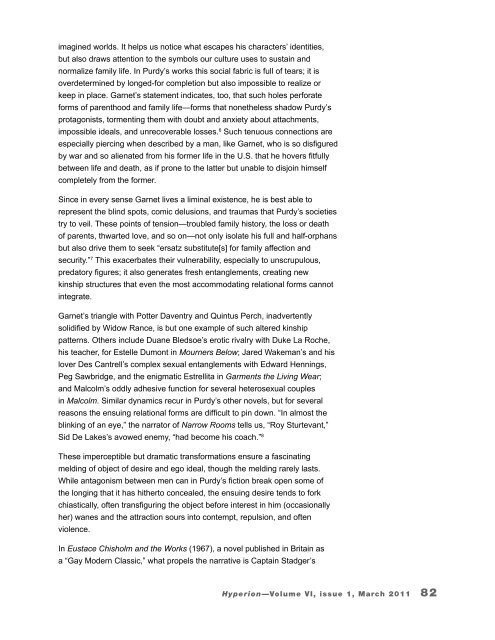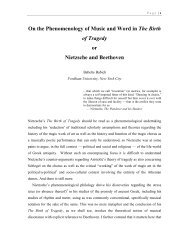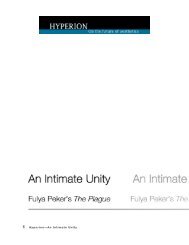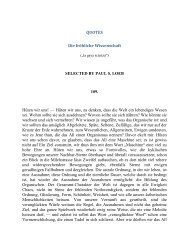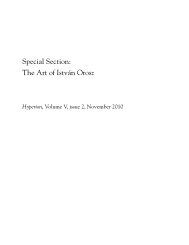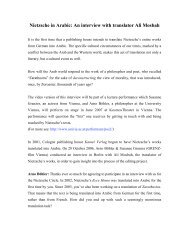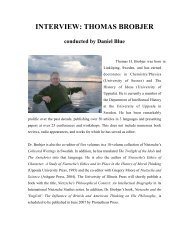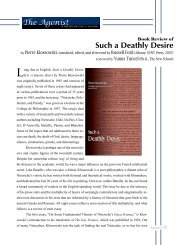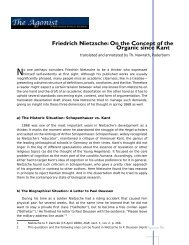Hyperion - Nietzsche Circle
Hyperion - Nietzsche Circle
Hyperion - Nietzsche Circle
Create successful ePaper yourself
Turn your PDF publications into a flip-book with our unique Google optimized e-Paper software.
imagined worlds. It helps us notice what escapes his characters’ identities,<br />
but also draws attention to the symbols our culture uses to sustain and<br />
normalize family life. In Purdy’s works this social fabric is full of tears; it is<br />
overdetermined by longed-for completion but also impossible to realize or<br />
keep in place. Garnet’s statement indicates, too, that such holes perforate<br />
forms of parenthood and family life—forms that nonetheless shadow Purdy’s<br />
protagonists, tormenting them with doubt and anxiety about attachments,<br />
impossible ideals, and unrecoverable losses. 6 Such tenuous connections are<br />
especially piercing when described by a man, like Garnet, who is so disfigured<br />
by war and so alienated from his former life in the U.S. that he hovers fitfully<br />
between life and death, as if prone to the latter but unable to disjoin himself<br />
completely from the former.<br />
Since in every sense Garnet lives a liminal existence, he is best able to<br />
represent the blind spots, comic delusions, and traumas that Purdy’s societies<br />
try to veil. These points of tension—troubled family history, the loss or death<br />
of parents, thwarted love, and so on—not only isolate his full and half-orphans<br />
but also drive them to seek “ersatz substitute[s] for family affection and<br />
security.” 7 This exacerbates their vulnerability, especially to unscrupulous,<br />
predatory figures; it also generates fresh entanglements, creating new<br />
kinship structures that even the most accommodating relational forms cannot<br />
integrate.<br />
Garnet’s triangle with Potter Daventry and Quintus Perch, inadvertently<br />
solidified by Widow Rance, is but one example of such altered kinship<br />
patterns. Others include Duane Bledsoe’s erotic rivalry with Duke La Roche,<br />
his teacher, for Estelle Dumont in Mourners Below; Jared Wakeman’s and his<br />
lover Des Cantrell’s complex sexual entanglements with Edward Hennings,<br />
Peg Sawbridge, and the enigmatic Estrellita in Garments the Living Wear;<br />
and Malcolm’s oddly adhesive function for several heterosexual couples<br />
in Malcolm. Similar dynamics recur in Purdy’s other novels, but for several<br />
reasons the ensuing relational forms are difficult to pin down. “In almost the<br />
blinking of an eye,” the narrator of Narrow Rooms tells us, “Roy Sturtevant,”<br />
Sid De Lakes’s avowed enemy, “had become his coach.” 8<br />
These imperceptible but dramatic transformations ensure a fascinating<br />
melding of object of desire and ego ideal, though the melding rarely lasts.<br />
While antagonism between men can in Purdy’s fiction break open some of<br />
the longing that it has hitherto concealed, the ensuing desire tends to fork<br />
chiastically, often transfiguring the object before interest in him (occasionally<br />
her) wanes and the attraction sours into contempt, repulsion, and often<br />
violence.<br />
In Eustace Chisholm and the Works (1967), a novel published in Britain as<br />
a “Gay Modern Classic,” what propels the narrative is Captain Stadger’s<br />
<strong>Hyperion</strong>—Volume VI, issue 1, March 2011 82


